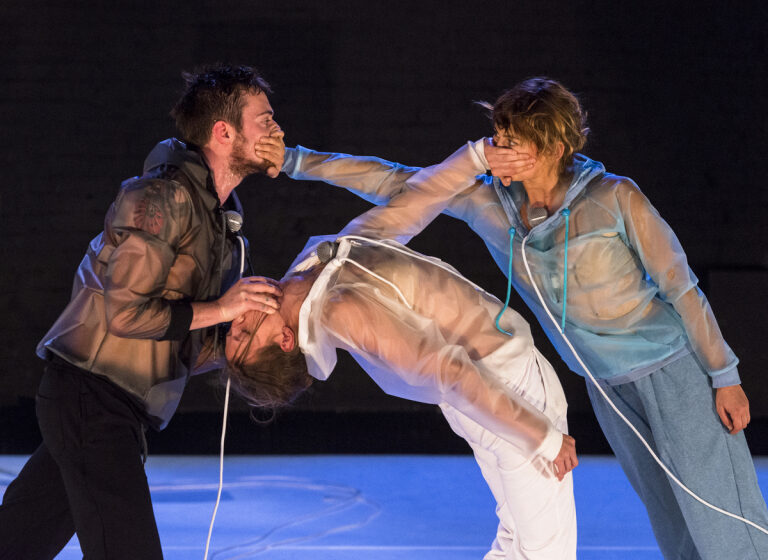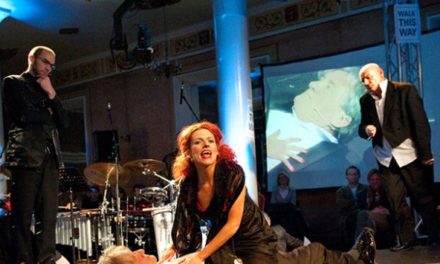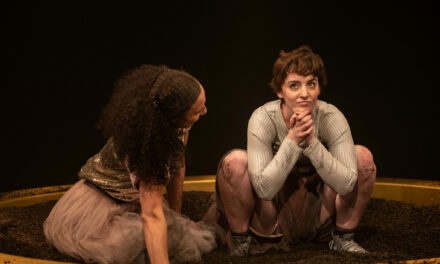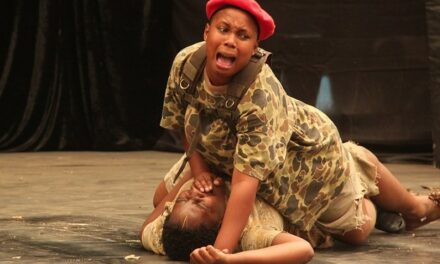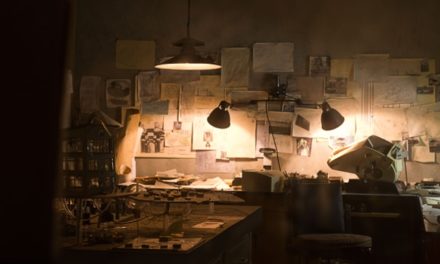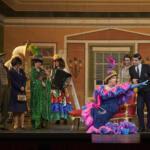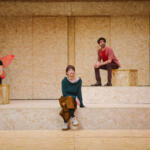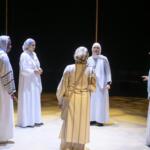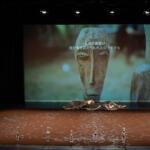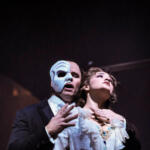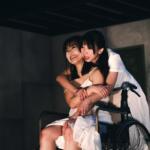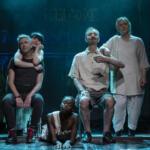The Theatre Times recently republished an article called “A New Form of Theatre Consumption Aims to Revolutionize the World of Theatre.” If you have been following our transmedia section, you will remember several examples of theatre-makers trying to revolutionize the theatre world in recent years. Lots of directors, playwrights, dancers, choreographers, companies, performers are including newly developed technological tools in their stagings, making a plethora of manifestations of highly technological theatre and networked performances all over the world, but this particular article got us thinking, and it was mainly because of the breakdown of topics involved in the project: sound, vision, and touch.
The article also mentioned Mischa Dohler, Professor of Wireless Communications, driving cross-disciplinary research and innovation in technology, sciences, and arts at King’s College London. We contacted him, and he kindly agreed to talk with us about the Connected Culture project he co-directs with the prominent American–UK artist Ali Hossaini.
Connected Culture explores what happens when drama, technology, and architecture converge. It goes a step further in the method of producing theatrical experiences through ‘networked performances,’ which enable musicians, actors, singers and artists located in different time zones to perform as one company in a single real-time production that can be watched by audiences located in any part of the globe. To confront the complex engineering and artistic challenges of networked performance, a 30-strong team of academics, directors, artists, producers and telecommunications experts broke them into a series of discrete topics—sound, vision, and touch.
And these three topics together are what make this experience really innovative because it is giving us, theatre-makers, new tools to play with. Connected Culture tests actual new technologies, technologies still not available to those not building them. What technologies are we talking about? The ZD Immersive Audio system, large-scale video, VR, augmented reality, and gloves and haptic devices. Now engage your theatre mind to play with all that and create a networked performance that makes use of them in a justified and natural way. Isn’t that exciting? That’s what they are doing.
They are using theatre to do what we do best, create little mockup realities, plausible worlds inhabited by flesh-and-blood characters, to allow science to control test its capabilities. While theatre pushes technology forward, science challenges theatre’s boundaries. Newly developed tools allow us to reach our audiences in different ways and to create more complex narratives and worlds inhabited by characters made up of bytes and bits. We are a perfect marriage.
Our conversation with Professor Mischa Dohler covered a broad range of topics; we present to you, below, in his own words, the fields he is currently working in that have applications in the theatre world.
About developing and establishing 5G:
M.D.: When I took over the centre [for Telecommunications Research at King’s College London] three years ago, I said, if we start developing a new technology, which is 5G in this case, we need to make sure we don’t develop the technology for the sake of the technology but to have it actually applied to certain areas, like to health, to arts, to finance . . . let’s reach out to the people and figure out do they really need this stuff? Is 4G maybe really good enough? Do they need 5G? That was the rationale; then we developed the vision further and further, and at some point, I asked my centre, guys you know, what happened with TV? TV was disrupted by Netflix, fundamentally, and it was disrupted in a way that totally changed the way we consume TV, and it also changed the way we procure content.
I asked my team, why can’t we come up with a technology, a platform, whatever, which would disrupt theatre the same way? Because theatre hasn’t been disrupted since whatever, Shakespeare’s time? So, we started looking at new ways of consuming art but also new ways of procuring art, if you look at Netflix, that series called Stranger Things? That series was procured in a way which was totally different from the traditional blockbuster. This are totally nonprofessional artists, actors, except one or two really well known, but the rest were total amateurs, so suddenly you were able to catapult people purely based on their talent and the platform was able to pick it up. So now look at theatre. Let’s make sure we are able to catapult artists purely based on their talent and bounding it to the pieces of art, we would love to use artists which are not necessarily in London: they could be literally in the rain forest. We can bring and mix different capabilities.
But if you want to do real time, musicians and actors are absolutely susceptible to delay, to latency. If you want to transmit video with a traditional codex there is about an 80-millisecond delay one way. Audio is about the same, so what’s the solution? Don’t encode the stuff, from screen to screen, just push it through; but if you don’t encode it, suddenly your video, your 4K video, occupies a lot, and this is why we need 5G.
We also talked about the haptic-tactile experience. This is something way bigger than it looks at a first glance. Mischa will be giving the opening Plenary Keynote at the upcoming OFC conference in Los Angeles at the end of March. The keynote will end with him launching his fifth album, “Stories from Another World,” and playing the piano:
M.D.: The haptic gloves will take the movements and project them on the screen. My idea is to build an Internet of Skills, the next generation Internet, in which I could teach somebody how to play the piano, somebody can teach me how to paint, etc.; that type of ability is what we are constructing now, so I want to demonstrate the haptic equipment. We have 360 video as well, VR—all from innovative startup RoomOne.
My vision is to standardize the haptic experience. Touch is not a mass medium but we think one day it will be, so we are researching the tactile experience and which zones of the human body are more receptive. There are some areas which are surprisingly not receptive, especially when you move. Your susceptibility to touch goes down when we move. Then we started working with the ability to reproduce touch; I have haptic gloves from an innovative company, Neurodigital, in my lab where you can feel guitars, you can feel falling objects, you can feel heat; it’s really fascinating, just with some simple vibrations you have the feeling you are holding something which has weight which actually doesn’t have weight because you are not holding the real object. The brain is just amazing.
I am working on making it efficient and on standardizing it. For example, theatres don’t talk among themselves, I don’t expect the Globe to talk to Sadler’s Wells or to National Theatre too much, so if you standardize the procedures and the equipment you would standardize skills so people could move freely, you bring down the costs . . . we are on top of that.
The theatre disruption he mentions has two sides; one is the way of procuring art:
M.D.: Being able to catapult artists purely based on their talent, in terms of artistic application, I see the ability to literally beam in an orchestra, then the next stage is to beam in disadvantaged kinds of artists, and then the third level would be to literally write good pieces of art, this is something which to me it has eluded still . . . with Jennifer [Jennifer Tang —a theatre director specializing in making new work across multiple disciplines] we were touching it; it was the first time I had the feeling we were there.
T.T.T.: The danger is that you have all these nice tools and it looks like you are just showcasing the technology.
M.D.: Yes, I don’t want that. That’s why I love this piece of Jennifer’s. It was a very emotional piece; there were three different venues. The thing is that the developed story is not about spatial distribution but temporal; it went on 20 years, 20 years, 20 years. When I saw this, even though it was just a snippet she played, literally my hair went up, and that is something which I think is so powerful, that you can’t do with a normal type of performance.
The second side of the theatre disruption is the way of consuming art:
M.D.: Now, regarding the consumption of art, everybody is putting a lot of effort into the idea of using VR and all that stuff, but we realized there are two modalities which have not been considered enough: one is audio and the other is touch; audio has not been disrupted since Dolby, twenty years. The audio is interesting because it is more developed than our eyes in a sense because it’s our radar in the back. As humans, we are super geared to audio. I have a professor in my centre called Zoran Cvetkovic, he came over from Berkeley, US, and he invented a new audio surround system; we have a chamber at King’s and it’s really fascinating. You should sit in this chamber and listen to its capabilities, it’s bringing the environment to you and he is doing this in real time.
T.T.T: What’s the difference between VR in theatre and in a game?
M.D.: In a game, VR is a natural thing because the gaming experience is a ONE TO WORLD experience, but theatres are saying VR won’t take off because we are compartmentalizing the audiences, and the whole point is that if I’m in the theatre I want to see who’s beside me, I want to hear you breathing, and we are not there yet in VR, to recreate that feeling. It’s still too secluded; once I put the headset on you are not here anymore.
T.T.T: Put me in.
M.D.: If you come into my virtual world, yeah, but we are not there yet.
T.T.T: Don’t you just need cameras around that go into the feed of the VR at the same time? . . . or fake it and record the audience one day. You won’t be seeing the person that is there now but the recording of another person who was there, so technologically it is easier.
M.D.: But you will be cheating the liveness. The important thing I would like to highlight is that I am trying to disrupt the world in the sense of bringing the theatre world out of verticals. I want to horizontalize the capabilities and bring down costs, build a platform which allows us to build a homogeneous set of skills and then democratize it.
We were about to finish our conversation, and then the last question turned out to have one of the most inspiring responses:
T.T.T: How do you imagine the future audience?
M.D.: Atomized and empowered. Atomization maybe in the sense that you can literally individualize the theatre experience. For example, La Fura dels Baus’s shows are super intense; some people love it, some people hate it. People really freaked out because they make you uncomfortable, but the levels of discomfort are different for everybody; it doesn’t mean you have to push people over the cliff. So if you have these types of capabilities you can actually individualize these experiences. And empowerment means that if you want to participate in the act, one way or another, because currently the audience . . . theatre is currently more kind of a relaxation thing after hard work rather than like an experience, as it would be go to Disney. The atomization allows us to differentiate between those who want just to lay back and have a nice relaxing evening without being pushed over the edge whereas others want to be pushed over their own edge which is different from the other people’s edge and the third part maybe even want to participate, through some actuation, some visuals, etc., and that capability is what we should really strive for. That for me would be the real disruption in the theatre world which hasn’t happened since Shakespeare.
So now, dear reader, exercise your imagination with me and put it all together in your mind at the same time: 5G; the standardized new sound system, immersive VR, and tactile haptic experience; the democratization of skills; the networked performances; the development of a specific way of writing and the atomized and empowered audience. If you succeeded in this little exercise, you would be peeking through a keyhole into the future stage. Let’s just open the door.
https://youtube.com/watch?v=hQ-3arrRsTg
This post was written by the author in their personal capacity.The opinions expressed in this article are the author’s own and do not reflect the view of The Theatre Times, their staff or collaborators.
This post was written by Beatriz Cabur.
The views expressed here belong to the author and do not necessarily reflect our views and opinions.

